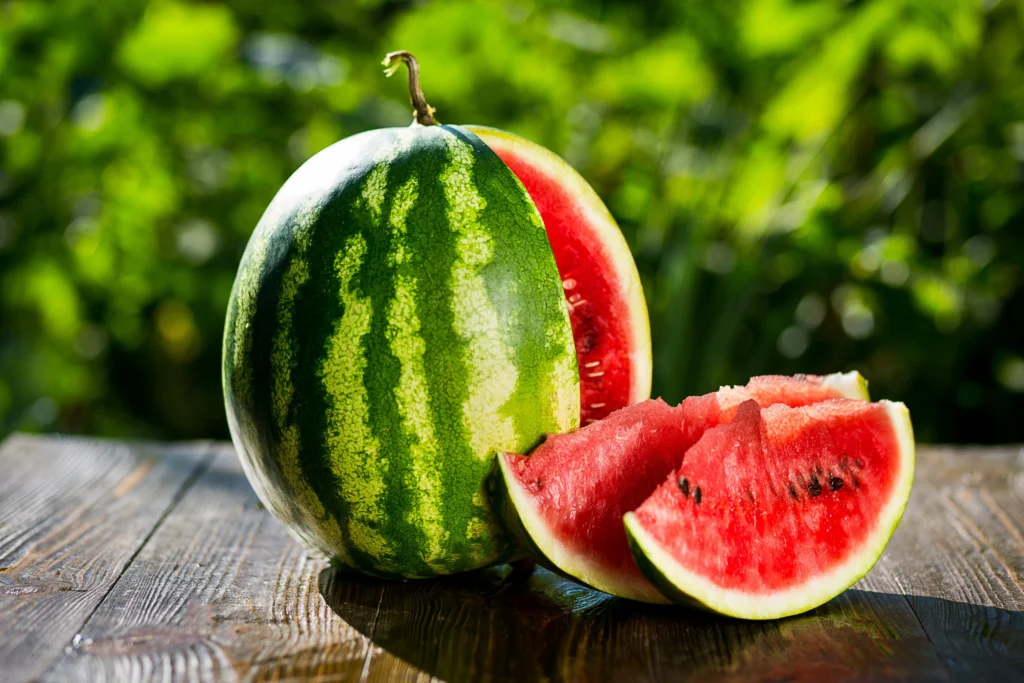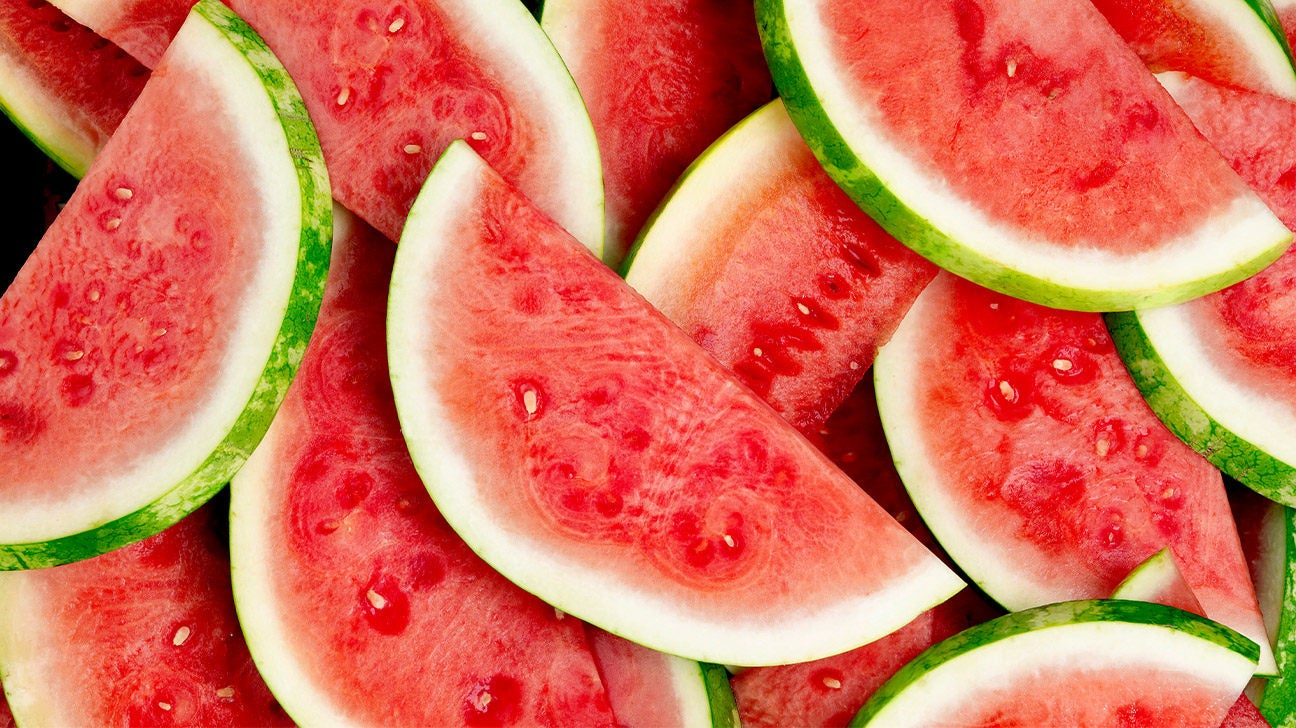Introduction
Picture this: it’s a sweltering summer afternoon, and you’re dreaming of biting into a crisp, juicy slice of watermelon. You head to the market, excited to bring home the perfect one — but with so many options, how do you know which watermelon is ripe, sweet, and ready to devour?
Choosing the right watermelon isn’t a guessing game — it’s a skill anyone can learn. In this guide, you’ll discover the simple signs of ripeness, expert tips to avoid common mistakes, and easy techniques to ensure every watermelon you select is bursting with flavor.
Why Choosing a Ripe Watermelon Matters
Selecting a ripe watermelon offers far more than just good taste. Here’s why it matters:
- Unmatched Sweetness: A perfectly ripe watermelon delivers peak sugar content for the sweetest, most refreshing bite.
- Hydration Hero: With over 90% water content, watermelon is nature’s ultimate thirst-quencher on hot days.
- Nutritional Powerhouse: Fully ripened melons are packed with antioxidants, vitamin C, and other nutrients.
- No Waste: A ripe melon means fewer disappointments and less food waste at home.
- Cooking & Entertaining: Whether used in salads, drinks, or desserts, ripe watermelon elevates any dish.
How to Select a Perfect Watermelon
Mastering watermelon selection is easier than you think. Use the tips below to guide your choice every time.
Weight & Size
When you pick up a watermelon, it should feel heavy for its size. Heftiness indicates a high water content — the melon is dense and juicy inside. A light watermelon for its size likely means it’s dry or underripe.
Field Spot (C‑spot)
Turn the melon over and check for a creamy yellow spot. This “field spot” is where the watermelon rested on the ground as it ripened. A rich, buttery yellow hue indicates it ripened naturally. If the spot is pale green or white, the fruit was likely harvested too soon.
Appearance & Rind Texture
The rind should look dull, not shiny. A glossy surface suggests underripeness. Choose a watermelon with a matte finish and consistent striping or patterning. The rind should also feel firm and resist slight pressure — no soft patches, cracks, or bruises.
Knock/Test Sound
This old-fashioned trick really works! Gently tap the watermelon with your knuckles or palm. A deep, hollow “thump” means the flesh is ripe and full of juice. A flat or high-pitched sound often signals an underripe or overripe fruit.
Stem Condition
Examine the stem (if present). A brown, dried stem is a great sign — it means the watermelon was allowed to fully ripen on the vine before being harvested. In contrast, a green, fresh-looking stem indicates the melon was picked too early.
Shape & Symmetry
Look for watermelons that are symmetrical — either uniformly round or oval. Irregular shapes or lumpy sides often mean the fruit developed unevenly and may have an inconsistent texture or taste inside.
Webbing & Sugar Spots
Brown web-like markings or small sugar spots on the rind are signs of sweetness. These markings appear when sugar seeps from the fruit during ripening, signaling high sugar content inside.
Step-by-Step Watermelon Selection Guide

Here’s an easy-to-remember sequence you can follow at the store or market:
1️⃣ Check the Shape
Go for a uniformly shaped melon — round or oval is fine, as long as it’s symmetrical.
2️⃣ Inspect the Field Spot
Look for a creamy yellow patch. Avoid melons with white or pale spots.
3️⃣ Lift and Feel the Weight
Pick several melons of similar size. The heaviest one is usually the juiciest.
4️⃣ Tap and Listen
Give it a gentle tap. Listen for a deep, hollow sound — the telltale “thump” of ripeness.
5️⃣ Examine the Stem
If the stem is present, it should be brown and dried, not green.
6️⃣ Look for Sugar Spots and Webbing
Brown webbing and sugar spots are signs of sweetness.
7️⃣ Assess the Rind Texture
Choose a melon with a dull finish and a firm, uniform rind.
8️⃣ Final Check
Give the watermelon a final once-over: no soft spots, bruises, or major blemishes.
Common Mistakes & How to Avoid Them
Even experienced shoppers sometimes get fooled. Here’s how to avoid the most common watermelon selection mistakes:
| Mistake | Why It’s a Problem | How to Avoid |
|---|---|---|
| Choosing a melon with a shiny rind | Glossy skin often means underripe | Pick one with a dull, matte rind |
| Ignoring the field spot | A pale spot means early harvest | Look for a creamy yellow field spot |
| Focusing only on size | Bigger isn’t always better | Prioritize weight for size |
| Overlooking symmetry | Irregular shapes can mean uneven ripening | Choose uniformly shaped melons |
| Forgetting the tap test | The sound reveals ripeness | Always perform the knock test |
Seasonal & Regional Tips
Timing and location can make a big difference when selecting watermelons. Keep these tips in mind:
Best Season to Buy
Watermelon season peaks from late spring to early fall. In most regions, June through August is prime time for local, vine-ripened watermelons. Out-of-season melons are more likely to be picked prematurely and may lack sweetness.
Hot Climate Considerations
In very hot growing regions, watermelons often develop more pronounced field spots and richer sugar content. Be sure to pay attention to webbing and color in these areas.
Cooler Climate Tips
If you live in a cooler climate where watermelon growing seasons are short, consider trying smaller varieties or seedless types. They ripen faster and often deliver better flavor in cooler zones.
Farmers’ Market Advantage
Shopping at farmers’ markets offers the benefit of local, vine-ripened fruit. Don’t hesitate to ask vendors about their harvest and variety — they’re usually happy to help you pick the perfect one.
Tools & Materials Checklist 🛠️
Here’s what you need to become a watermelon-picking pro:
- 🧴 Clean rag: For wiping off dirt and better viewing rind color
- 👂 Quiet space: Helps you hear the knock test clearly
- 📱 Good lighting: Natural light or phone flashlight for inspecting colors
- 🤏 Strong hands: To lift and compare melon weights
- 📝 Curious mindset: To explore new watermelon varieties and flavors
Benefits of Picking the Best Watermelon
Selecting the perfect watermelon delivers more than just taste — here’s what you gain:
- Incredible Flavor
Nothing beats the natural sweetness of a perfectly ripe watermelon. - Superior Hydration
Watermelon helps replenish fluids and electrolytes during hot weather. - Enhanced Nutrition
A ripe melon provides antioxidants like lycopene, vitamin C, and potassium. - Kitchen Versatility
Perfect for fruit salads, smoothies, salsas, grilled dishes, and refreshing drinks. - Social Success
Bring a juicy watermelon to a picnic or barbecue, and you’re sure to be a crowd favorite!
FAQs
How can I tell if a watermelon is ripe?
Look for a creamy yellow field spot, a deep hollow sound when tapped, heavy weight for its size, a dull rind, and a brown, dried stem.
Do watermelons ripen after picking?
No. Once picked, watermelons do not continue to ripen. Always choose one that is already ripe.
What is a field spot and what color should it be?
The field spot is the area where the watermelon rested on the ground. A creamy yellow or buttery-colored spot indicates the fruit ripened naturally.
Why does knocking help?
A deep, hollow sound indicates that the flesh is ripe and juicy inside. A flat or dull sound usually means the fruit is underripe or overripe.
How long do ripe watermelons last?
Whole ripe watermelons can be stored at room temperature for about 7–10 days. Once cut, they should be refrigerated and consumed within 3–4 days for optimal flavor and freshness.
Anchor text: hydration benefits of watermelon
URL: https://www.medicalnewstoday.com/articles/watermelon-health-benefits
Suggested placement: In the “Why Choosing a Ripe Watermelon Matters” section when mentioning its hydration power.
2️⃣ Anchor text: how to store cut watermelon
URL: https://www.eatright.org/food/planning-and-prep/food-storage-and-safety/how-to-keep-watermelon-fresh
Suggested placement: In the FAQ answer about how long ripe watermelon lasts.
3️⃣ Anchor text: nutritional profile of watermelon
URL: https://nutritiondata.self.com/facts/fruits-and-fruit-juices/2072/2
Suggested placement: In the “Benefits of Picking the Best Watermelon” section when listing the nutrition and vitamins.


generic amoxil – combamoxi.com amoxicillin uk
purchase forcan sale – site oral forcan
lexapro order – https://escitapro.com/ buy generic lexapro 10mg
cenforce online order – order cenforce 100mg sale buy cenforce 100mg generic
is tadalafil from india safe – fast ciltad cialis prescription online
where can i buy cialis online in canada – https://strongtadafl.com/# when to take cialis for best results
where can i buy viagra in la – can you buy viagra in thailand viagra 50 mg buy online
Greetings! Utter useful par‘nesis within this article! It’s the scarcely changes which wish turn the largest changes. Thanks a portion quest of sharing! https://buyfastonl.com/furosemide.html
More posts like this would create the online play more useful. this
This is the big-hearted of writing I rightly appreciate. https://prohnrg.com/product/rosuvastatin-for-sale/
More peace pieces like this would make the web better. https://ursxdol.com/get-metformin-pills/
I couldn’t turn down commenting. Profoundly written! https://aranitidine.com/fr/viagra-professional-100-mg/
This is the stripe of serenity I enjoy reading. https://ondactone.com/spironolactone/
Thanks on sharing. It’s acme quality.
buy zantac without a prescription
More text pieces like this would create the web better. http://furiouslyeclectic.com/forum/member.php?action=profile&uid=24578
buy forxiga – https://janozin.com/ dapagliflozin 10 mg canada
buy generic xenical – https://asacostat.com/ buy xenical 60mg pills
This website positively has all of the bumf and facts I needed adjacent to this thesis and didn’t positive who to ask. http://sglpw.cn/home.php?mod=space&uid=570662
You can shelter yourself and your stock by way of being heedful when buying pharmaceutical online. Some pharmacopoeia websites control legally and provide convenience, solitariness, bring in savings and safeguards to purchasing medicines. buy in TerbinaPharmacy https://terbinafines.com/product/prednisone.html prednisone
This is the kind of glad I enjoy reading. aranitidine.com
I couldn’t weather commenting. Warmly written!
187975 683265Hello there! Do you know if they make any plugins to protect against hackers? Im kinda paranoid about losing everything Ive worked hard on. Any suggestions? 276005